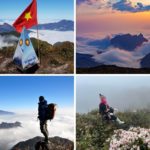Mountain climbing and trekking are exhilarating outdoor activities that require careful preparation to ensure a safe and enjoyable experience. Let’s explore the essential items you’ll need for your next adventure!
1. Essential Gear for Mountain Climbing
Must-Have Climbing Equipment
The following climbing gear is essential for your packing list when embarking on a lengthy trek:
- Mountain Climbing Backpack: Opt for a spacious backpack to accommodate all your necessary items.
- Hiking Shoes: Invest in a pair of professional hiking shoes to provide traction and comfort during your journey. Choose a pair suitable for the terrain you’ll be navigating.
- Trekking Poles: These poles help maintain balance, reduce the impact on your feet, and assist in navigating challenging terrain with ease.
- Mountain Climbing Gloves: Gloves offer improved grip and protect your hands during the climb.
- Flashlight: A vital tool for navigating through the great outdoors, especially during evening adventures and camping trips.
- Map, Compass, and GPS: These tools are essential for wilderness navigation, ensuring you don’t get lost in the woods.
 Mandatory Climbing Gear
Mandatory Climbing Gear
Camping Gear
If you’re planning an overnight or multi-day trek, don’t forget to bring along these basic camping essentials:
- Tent: A tent provides a resting space after a strenuous climb, shielding you from the elements.
- Sleeping Bag: Sleeping bags offer warmth and protection, ensuring a comfortable night’s rest for all adventurers.
- Picnic Mat: A mat allows for easy and hygienic dining during your mountain picnic breaks.
 Camping Gear
Camping Gear
Clothing for Mountain Climbing
Clothing is a crucial consideration for any outdoor adventure. If you’re unsure about what to wear, here are some suggestions:
- Mountain Climbing Jacket
- Hiking Pants
- Rain Gear for Climbing
- Camping Clothes
- Underwear and Socks
 Camping Gear
Camping Gear
Personal Hygiene Items
Don’t forget to bring along or purchase some basic personal hygiene items before your mountain climbing trip, especially for extended journeys:
- Hand Sanitizer
- +
- Personal Hygiene Kit
- ,
 Personal Hygiene Items
Personal Hygiene Items
Medical Supplies
Mountain climbing locations are often secluded, so it’s crucial to be prepared with essential medical supplies. Some basic medications to consider include stomach relief, painkillers, headache tablets, fever reducers, and glucose.
- First Aid Kit
- Insect Repellent Spray
 Medical Supplies
Medical Supplies
Water and Food
Water is essential when preparing for a mountain climb, as your body loses fluids during strenuous activity. Aim for approximately 2 liters of water per person per day. Additionally, consider packing a glucose packet to maintain energy levels when fatigue sets in.
- Drinking Water
- Snacks
- Main Meals
 Water and Food
Water and Food
Identification Documents
Don’t forget to bring along your identification documents, a necessity for any traveler embarking on a journey:
- ID Card
- Cash
- Mobile Phone
- Power Bank
 Identification Documents
Identification Documents
2. Mountain Climbing Tips and Precautions
Choose Shorter Trails That Match Your Ability Level
For your first mountain climbing experience, avoid selecting a lengthy route. Pushing yourself too far can be dangerous and exhausting. Start with a manageable altitude and gradually work your way up as you gain experience and confidence.
Only Bring What You Truly Need
Mountain climbing can be physically demanding, and for beginners, it may even be dangerous. Keep your backpack light and mobile, carrying only the essentials to make your journey more enjoyable and safe.
 Choose Suitable Trails
Choose Suitable Trails
Learn to Use Survival Gear Before Your Trip
Familiarize yourself with survival gear usage as part of your mountain climbing preparation. Knowing how to use these tools can make all the difference in an emergency.
Pace Yourself and Conserve Energy
To maintain energy levels throughout your journey, it’s essential to pace yourself. Take regular breaks and plan a reasonable itinerary to ensure you don’t overexert yourself.
Additional Precautions
Don’t forget the importance of insect protection. Wear long, protective clothing to avoid mosquito bites. When resting, choose a spacious, clean area with minimal vegetation. Avoid consuming unknown plants or fruits, as some may be poisonous.
 Additional Precautions
Additional Precautions
We hope these tips will help you embark on a safe and enjoyable mountain climbing adventure. Happy climbing, and stay safe out there!
Trekking Mount Cuixin, Lost in an Ethereal Cloud and Mountain Wonderland
 Mountain Wonderland’>
Mountain Wonderland’>Trekking Ky Quan San in late April, when the weather is pleasantly warm and rhododendrons are blooming profusely throughout the northwestern mountain forests. Let’s go right away!
































